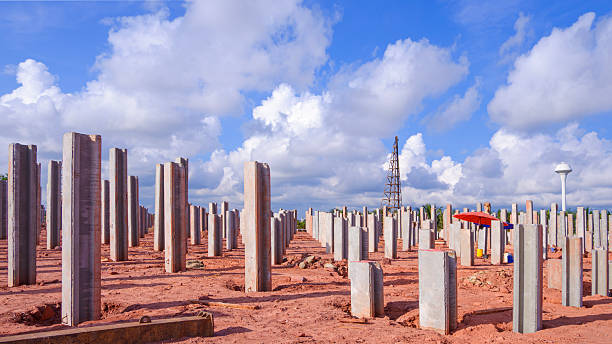Top Challenges in Commercial Piling and How to Overcome Them

Introduction
Commercial piling plays a crucial role in creating stable, long-lasting foundations for large buildings and infrastructure. While the process may seem straightforward from the outside, it involves complex technical, environmental, and logistical challenges. Developers, engineers, and contractors often face significant obstacles that can delay projects, increase costs, or compromise structural integrity. By understanding these challenges in advance and preparing strategic solutions, construction teams can complete projects efficiently and ensure strong foundation performance for decades.
Understanding the Complex Nature of Commercial Piling
Piling involves transferring the load of a structure deep into the ground, bypassing weaker surface soils. In commercial projects, the scale and weight of the structures often require advanced techniques and precision. Unlike residential piling, commercial projects deal with higher load requirements, diverse soil conditions, and tighter timelines. This makes proactive planning, site evaluation, and collaboration between engineers and contractors absolutely essential.
Challenge 1: Unpredictable Ground Conditions
One of the most common challenges in commercial piling is the variability of soil and ground conditions. Unexpected layers of rock, clay, or water tables can significantly affect the type of piles needed and the equipment required. Poor soil bearing capacity can lead to deeper piles, increasing time and cost.
Overcoming the Challenge
A thorough geotechnical investigation before starting work is the most effective way to minimize surprises. Soil sampling, borehole drilling, and advanced ground scanning technologies allow engineers to choose the most suitable piling method in advance. This preparation can prevent delays and costly design changes during construction.
Challenge 2: Limited Site Access and Space Constraints
In busy urban areas, commercial piling often takes place on sites with limited access. Tight working spaces can restrict equipment movement, complicate pile installation, and create safety risks for workers and nearby structures.
Overcoming the Challenge
Specialized piling rigs designed for confined spaces can make a big difference. Coordination with surrounding property owners, clear traffic management plans, and precise scheduling of deliveries help maximize efficiency in restricted areas.
Challenge 3: Noise and Vibration Control
Piling activities generate noise and vibration, which can disrupt nearby businesses, residents, and sensitive equipment in surrounding buildings. Regulatory restrictions on working hours and permissible noise levels add to the complexity.
Overcoming the Challenge
Using low-vibration piling techniques such as auger piling or pressed-in piling can reduce disturbance. Installing noise barriers and scheduling high-impact activities during permitted hours ensures compliance with local regulations while maintaining good community relations.
Challenge 4: Environmental Regulations
Commercial projects today must comply with strict environmental standards. Issues such as soil contamination, water protection, and habitat preservation require careful planning. Non-compliance can result in legal penalties and project delays.
Overcoming the Challenge
Early engagement with environmental consultants ensures compliance from the start. Implementing eco-friendly piling solutions, reusing materials where possible, and proper waste management are critical steps for minimizing environmental impact.
Challenge 5: Managing Project Costs
Piling costs can escalate quickly due to unforeseen ground conditions, equipment delays, or design changes. Since piling forms the base of the entire structure, cutting corners is not an option.
Overcoming the Challenge
Accurate budgeting based on detailed site surveys helps control expenses. Building contingency allowances into project estimates provides flexibility to manage unexpected issues without halting progress.
Challenge 6: Time Pressures and Scheduling
Commercial developments often have strict deadlines due to financial and operational commitments. Delays in the piling phase can have a domino effect on the entire construction schedule.
Overcoming the Challenge
Adopting advanced project management software allows better tracking of timelines and coordination between teams. Prefabricated piles, where feasible, can speed up installation and reduce on-site work.
Challenge 7: Coordinating with Multiple Stakeholders
Piling projects require collaboration between architects, engineers, contractors, and regulatory authorities. Miscommunication between these parties can lead to errors, delays, and cost overruns.
Overcoming the Challenge
Holding regular coordination meetings and using centralized documentation systems ensures everyone has access to the latest plans and updates. Clear communication channels are essential for maintaining alignment throughout the project.
Challenge 8: Safety Concerns on Site
Piling sites present risks such as falling objects, heavy machinery accidents, and unstable ground conditions. A single safety lapse can lead to serious injuries and halt work.
Overcoming the Challenge
Strict adherence to safety protocols, regular worker training, and the use of modern safety equipment reduce accident risks. Assigning dedicated safety officers ensures continuous monitoring and quick response to potential hazards.
Challenge 9: Dealing with Old Infrastructure
In redevelopment projects, existing underground utilities, foundations, or historical structures can complicate piling. Accidental damage can result in costly repairs and legal complications.
Overcoming the Challenge
Conducting utility surveys and reviewing historical site records before starting work helps avoid damage. Non-invasive detection methods such as ground-penetrating radar are useful in identifying obstacles without disturbing the ground.
The Role of Technology in Overcoming Piling Challenges
Modern technology is transforming the piling industry. From 3D site modeling to automated rigs, innovations make it easier to predict, plan, and execute piling projects with greater accuracy. Partnering with companies experienced in Smart Engineering Foundations for Commercial Projects ensures that advanced methods are applied effectively, leading to improved quality and faster completion times.
Conclusion
Commercial piling is a complex process that demands expertise, planning, and adaptability. Challenges such as unpredictable soil conditions, environmental regulations, noise control, and tight deadlines can impact a project’s success. By investing in thorough site assessments, using specialized equipment, leveraging technology, and fostering strong communication among stakeholders, these obstacles can be effectively managed. Strong, reliable foundations not only support the structure above but also secure the long-term value and safety of the entire development.
